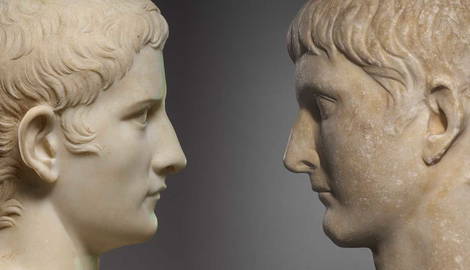
Germanicus was one of the most fascinating figures in the early Roman Empire. He was a member of the prestigious Julio-Claudian dynasty, established by the first Roman emperor Augustus. Young, charismatic and popular, he fulfilled all requirements for the purple. As a successful military commander, he fought the Illyrian revolt and led several campaigns against the Germans across the Rhine. It was there, in forests of Germania, that Germanicus avenged the Teutoburg disaster, recovering legionary eagles.
As an adoptive son of emperor Tiberius and potential heir, Germanicus enjoyed an accelerated political career, serving as a questor, consul and governor of several provinces. He was also an admirer of Alexander the Great and visited Egypt to honor his idol. It was in the East, in Syria, where Germanicus met his end. In 19 CE, he died in Antioch in suspicious circumstances. He therefore failed to ascend to the throne, but his legacy lived in his youngest son, future Emperor Caligula.
The Father of Emperor Caligula

Germanicus Julius Caesar – father of future Emperor Caligula – was the golden boy of the first Roman imperial family – the Julio Claudian dynasty. He was born in 15 BC to Nero Claudius Drusus and Antonia Minor, a niece of Emperor Augustus. Thus, from his very birth, young Germanicus was destined for greatness. It seems that Augustus agreed, as following the death of his chosen successor, Gaius Caesar, the emperor briefly considered Germanicus as his heir. However, his wife, Livia, convinced Augustus to choose his stepson Tiberius instead.
Yet, this was not the end for Germanicus’ imperial prospects; as a part of the early Roman Empire succession process, Augustus required Tiberius to adopt Germanicus. Thus, the young boy became second in the line of succession.
He Was a Successful General

Shortly after becoming the questor in 7 CE, five years before the legal age of 25, Germanicus left for Illyricum to help his adoptive father, Tiberius, to quell the rebellion of Pannonians and Dalmatians. The suppression of the Illyrian revolt was a clear sign that Germanicus was a capable commander. In 13 CE, he was made proconsul of Germania Inferior, Germania Superior, and all of Gaul. This gave Germanicus command over eight legions, one third of entire Roman army. Motivated to avenge the Roman defeat in the Teutoburg forest in 9 CE, Germanicus led his legions across the Rhine. They retrieved the three of two lost legionary eagles, the symbols of Roman military honor and prestige.
Fearing that Germanicus’ popularity among the legions might threaten his authority, emperor Tiberius recalled his adoptive son to Rome in 17 CE, awarding him the highest honor – the triumph.
Germanicus Restored Roman Prestige

Germanicus was not his original name but an agnomen, the honorary title added to the full name in 9 BC. The agnomen was actually awarded to Germanicus’ father, posthumously in recognition of his victories in Germania, the region opposite the Rhine. The agnomen Germanicus means “the Germanic one” or “the conqueror of the Germans.” Germanicus justified this honor by conducting three campaigns against the Germanic tribes. His most spectacular victories were in 16 CE, in the Battles of Idistaviso and the Battle of the Angrivarian Wall, near Elbe river. Germanicus led his legions even further, leading a naval expedition along the North Sea coast, where he explored and subdued local tribes.
Despite these victories, the effort to conquer Germania Magna was considered too great compared with the low gains from the new territories. Yet, his campaigns healed the trauma of the Varian disaster and restored the Roman prestige.
Germanicus Was Considered to Be Next Alexander the Great

Germanicus was more than a military man. He was also a history buff. En route to Syria, where he had to assume high command, he and his family traveled to Greece, where he visited the site of Actium, the victory that made his great-uncle Octavian the most powerful man in the Roman world. He also visited the legendary city of Troy, the mythical home of Aeneas, ancestor of Romulus and Remus and thus progenitor of the Roman people. By traveling East, the young general followed in the footsteps of his idol Alexander the Great. No wonder that when he visited Egypt in 19 CE, Germanicus made a pilgrimage to the burial site of a legendary conqueror in Alexandria. He was especially fond of the land and its history, using the opportunity to travel along the Nile and sightseeing ancient sites of pharaonic Egypt.
However, Germanicus’ trip to Egypt upset Tiberius because it had violated an order by Augustus that no senator shall enter the province without emperor’s permission.
He Died in Suspicious Circumstances

In 17 CE, Germanicus was given imperium maius, a high command in Asia, which placed all local governors and commanders under his command. His mission was to restore order in the turbulent region and maintain peace with Rome’s rival Parthia. He travelled to the Roman client state of Armenia, where he crowned a new king. He also made kingdoms of Cappadocia and Commagene the imperial provinces. However, the governor of Syria – Gnaeus Calpurnius Piso – had disobeyed and undermined Germanicus, actively working against his superior. The feud became so serious that Germanicus ordered Piso’s recall to Rome. A few days later, after attending the banquet in Antioch, on 10th October 19 CE, Germanicus fell ill and died. He was just 34.
On his deathbed, Germanicus blamed Piso for poisoning him. According to Tacitus, Suetonius and Cassius Dio, Piso acted with the consent of Emperor Tiberius, jealous of Germanicus. However, it is possible that Tiberius was not involved and that Germanicus fell victim to a powerful leader of the Praetorian Guard – Sejanus – who ruled the Empire all but in name.

Whatever transpired, a purge followed, which led to the death of most of Germanicus’ family. However, his youngest son, Caligula, survived the purge and, after Tiberius’s death, became the next Roman emperor in 37 CE, furthering Germanicus’ legacy.










